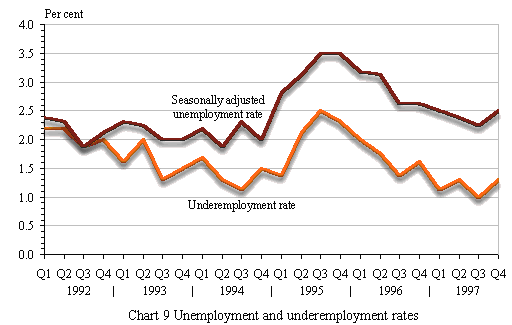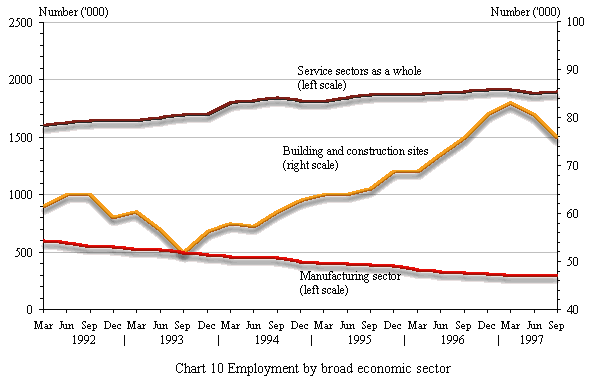The Labour Market
For most of 1997, labour market conditions tightened along with a further
pick-up in economic activity. There was however an easing in the fourth
quarter, following the correction in the asset markets and slackening in
local demand as the effect of the regional financial turmoil spread. The
seasonally adjusted unemployment rate fell steadily from 2.6 per cent in
the fourth quarter of 1996 to a low of 2.2 per cent in the third quarter of
1997, before rebounding to 2.5 per cent in the fourth quarter. The
underemployment rate exhibited a broadly similar trend. It fell from
1.6 per cent in the fourth quarter of 1996 to a low of 1 per cent in the
third quarter of 1997, before edging up to 1.3 per cent in the fourth
quarter.
Chart 9 Unemployment and underemployment
rates The labour
market tightened in 1997, having improved steadily in 1996.

There was a further notable growth in total labour supply, due to a
substantial inflow of returning emigrants and of immigrants from the
Mainland. But this was matched by an even faster growth in total
employment. Overall vacancies thus recorded a marked increase in the
first three quarters of 1997. However, towards the end of the year, there
was some easing in employment conditions.
Employment conditions for most of the semi-skilled and unskilled
occupations tightened earlier in the year, before easing in the latter period.
For 1997 as a whole, the unemployment rates for craft and related
workers, plant and machine operators and assemblers, service workers
and shop sales workers, clerks, and workers in elementary occupations
were all lower than in 1996, some by a considerable margin. Employment
conditions for occupations at the higher end remained tight throughout the
year, and with a lower unemployment rate than in the preceding year.
Employment in the service sectors as a whole reached 1 933 900 in
September 1997, little change from a year earlier. Among the service
sectors, employment in financing, insurance, real estate and business
services recorded an increase of 6 per cent, while employment in
community, social and personal services showed virtually no change.
Employment in the wholesale, retail, import/export trades and restaurants
and hotels as well as transport, storage and communications declined, by
2 per cent and 1 per cent respectively. Employment at building and
construction sites grew by only 2 per cent to 78 100 in September 1997.
The large decline in employment at public-sector sites due to the
completion of most of the projects under the Airport Core Programme
was more than offset by the pick-up in private-sector building activity.
Employment in the manufacturing sector remained on a down-trend with
a decline of 6 per cent over a year earlier to 309 200 in September 1997.
These were nevertheless more moderate than the double-digit declines in
earlier periods. Relocation of production processes outside Hong Kong,
while still continuing, thus appeared to have slowed somewhat.
Chart 10 Employment by broad economic
sector The structural shift
in employment from manufacturing to services continued in 1997.
Employment at construction sites rose sharply, along with hectic
building activity at private sector sites.

In the first three quarters of 1997 taken together, earnings in all of the
major sectors surveyed showed considerable increases in money terms,
and in some sectors, also notably in real terms over a year earlier,
reflecting the tighter labour market conditions for most of the year.
Wages in most major sectors surveyed also accelerated in growth.
However, the increases in earnings and wages could have turned more
moderate towards the year's end as the labour market tended to ease.
Chart 11 Earnings by broad economic sector
(year-on-year growth
rate in real terms) Earnings in both the manufacturing and the
services sector continued to rise in real terms in 1997.

[Back] [Forward]
|